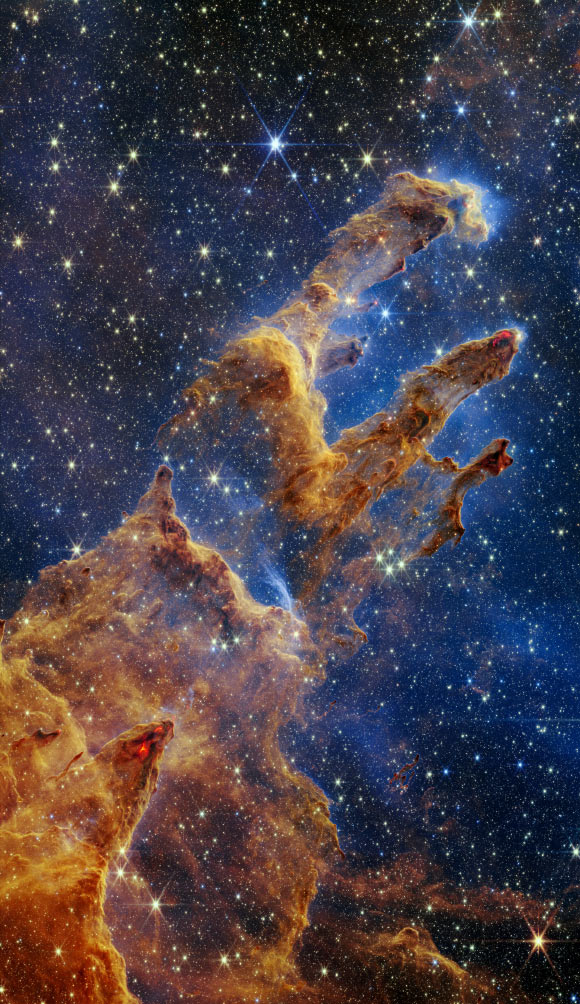Protostars are the scene-stealers in this new image of the Pillars of Creation from the Near-Infrared Camera (NIRCam) instrument aboard the NASA/ESA/CSA James Webb Space Telescope.

This image from Webb’s Near-Infrared Camera shows the Pillars of Creation. Image credit: NASA / ESA / CSA / STScI / Joseph DePasquale, STScI / Anton M. Koekemoer, STScI / Alyssa Pagan, STScI.
The three impressive towers of gas and dust are part of the Eagle Nebula, also known as Messier 16.
Discovered in 1745 by the Swiss astronomer Jean-Philippe Loys de Chéseaux, the nebula is located approximately 6,500 light-years away in the constellation of Serpens.
Stretching roughly 4 to 5 light-years, the Pillars of Creation are a fascinating but relatively small feature of the nebula, which spans 70 by 55 light-years.
The pillars arise when immense, freshly formed blue-white O- and B-type stars give off intense ultraviolet radiation and stellar winds that blow away less dense materials from their vicinity.
Denser pockets of gas and dust, however, can resist this erosion for longer. Behind such thicker dust pockets, material is shielded from the harsh, withering glare of O and B stars.
This shielding creates dark ‘tails’ or ‘elephant trunks,’ which astronomers see as the dusky body of a pillar, that point away from the brilliant stars.
The Pillars of Creation were first made famous when imaged by the NASA/ESA Hubble Space Telescope in 1995, and revisited in 2014, but many other observatories have also stared deeply at this region.
“Newly formed stars are the scene-stealers in this NIRCam image,” Webb astronomers said.
“These are the bright red orbs that typically have diffraction spikes and lie outside one of the dusty pillars.”
“When knots with sufficient mass form within the pillars of gas and dust, they begin to collapse under their own gravity, slowly heat up, and eventually form new stars.”
“What about those wavy lines that look like lava at the edges of some pillars?” they added.
“These are ejections from stars that are still forming within the gas and dust.”
“Young stars periodically shoot out supersonic jets that collide with clouds of material, like these thick pillars.”
“This sometimes also results in bow shocks, which can form wavy patterns like a boat does as it moves through water.”
“The crimson glow comes from the energetic hydrogen molecules that result from jets and shocks.”
“This is evident in the second and third pillars from the top — the NIRCam image is practically pulsing with their activity. These young stars are estimated to be only a few hundred thousand years old,” the astronomers said.
“Although it may appear that near-infrared light has allowed Webb to pierce through the clouds to reveal great cosmic distances beyond the pillars, there are no galaxies in this view.”
“Instead, a mix of translucent gas and dust known as the interstellar medium in the densest part of our Milky Way Galaxy’s disk blocks our view of the deeper Universe.”







